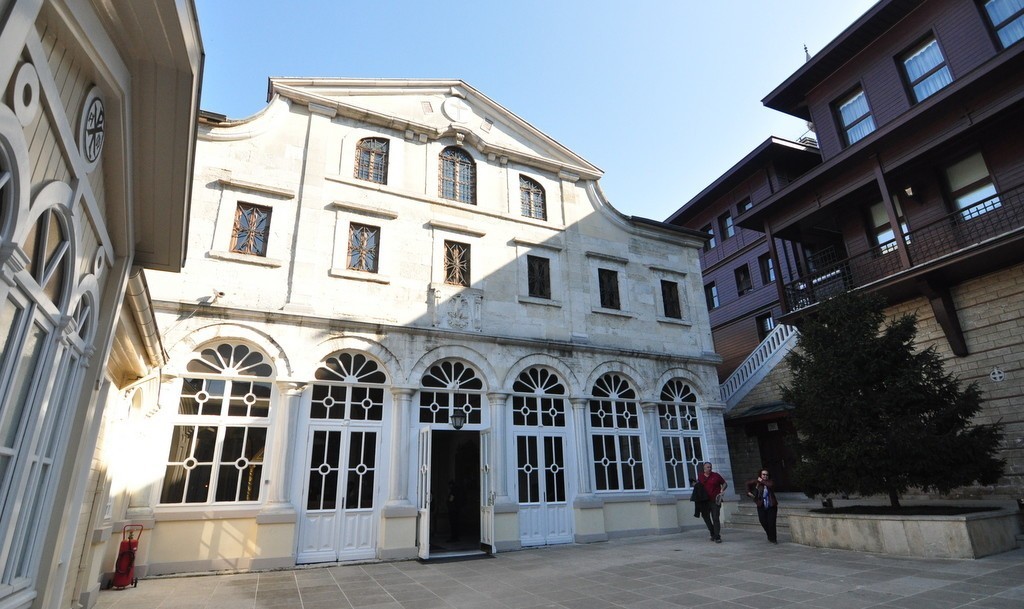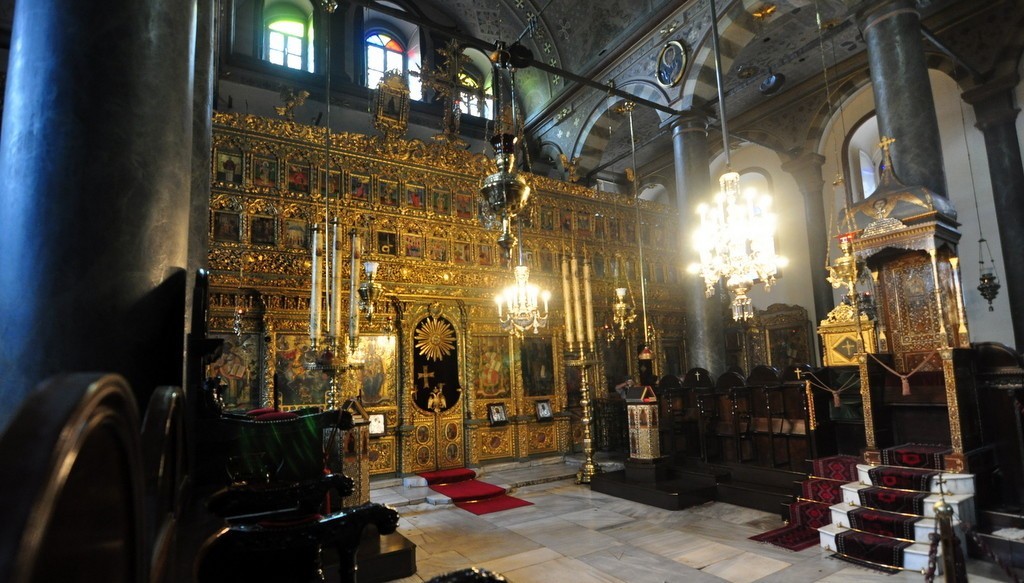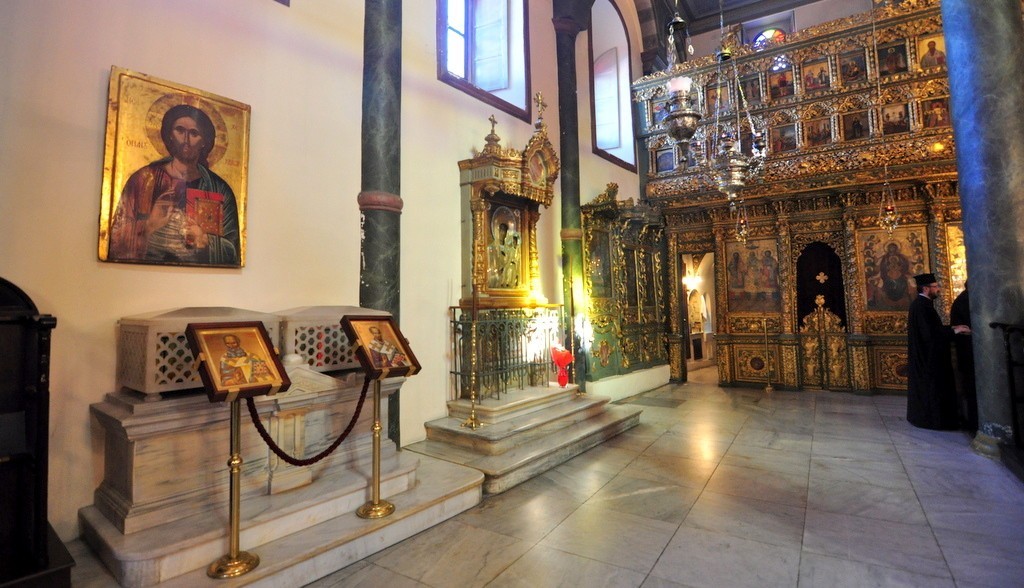Patriarchal Church of St George is located in Fener district of Istanbul. The church is located within the Greek Orthodox Patriarchate complex and has been the seat of the Patriarch of Constantinople for 430 years.
During the Byzantine Empire, the Ecumenical Patriarchate of Constantinople was operating in Hagia Sophia. After the Ottoman conquest in 1453, the Patriarchate moved to the Church of the Holy Apostles, the second largest church in the city.
Afterwards, the Pammakaristos Church served as the patriarchal church for 150 years. And then the Orthodox Patriarchate finally moved to its present location, the Church of St George, in 1590.
In this article, you can find information about the Fener Greek Orthodox Patriarchate and its most important structure, the Church of St George. However, to indicate why the Ecumenical Patriarchate of Constantinople was important, we will first have to take a short journey through Christian history.
Ecumenical Patriarchate of Constantinople
The Ecumenical Patriarchate of Constantinople has a very important place in Christian history. The Byzantine Empire was the driving force of the Christian world for many years with the legitimacy it received from Ancient Rome. In the years when Byzantium dominated Italy, there was a great rivalry between the Pope and the Patriarch. But now we rewind to the very beginning and look at where this rivalry originated.
1. Spread of Christianity
The Apostles of Jesus Christ continued spreading the teachings of Christianity after his death and they aimed to spread it also on the Mediterranean coast that was the center of the world in the Ancient Age.
St. Peter and St. Paul traveled as far as to Rome, which was the most important city in the Ancient Age. Furthermore, Alexandria, Jerusalem, Antioch, Ephesus and Byzantium were also among the important centers of Christianity.
Christians who lived under the Roman Empire were persecuted for 300 years due to their beliefs. Therefore, they built churches and monasteries inside deep valleys or on steep rocks as we see in Cappadocia and they continued following their religion despite tough measures and pressure from the Roman authorities.
2. Constantine the Great
The first Roman emperor who realized the unstoppable rise of Christianity was Constantine the Great. Emperor Constantine wanted to utilize this new and strong belief as a driving force to unite the Roman Empire that was on the course of fall.
Emperor Constantine issued the Edict of Milan in 315 for this purpose and put an end to 300 years of persecution. Thus, Christians could worship freely.
3. First Ecumenical Council of Nicaea
Upon converting to Christianity, the first thing Emperor Constantine did was to create a strong organization. Thus, he gathered First Ecumenical Council of Nicaea. This council laid the foundations for the official organization of Christianity.
In this council, Rome, Constantinople, Antioch, Jerusalem, and Alexandria were recognized as the five religious centers of Christianity. Known as the Pentarchy, this system represented the five patriarchal sees.
In each of these cities a bishop was appointed. Each would become the religious authority in their region. Although Alexandria was also prominent during the reign of some powerful bishops, the two main centers of authority were Rome and Constantinople.
4. The Great Schism
Rome had the legacy of Saint Peter. For this reason, the Pope was considered the first among equals. However, since the Roman emperors lived in the East from the 4th century onwards, the Patriarch of Constantinople could challenge him.
This rivalry led to conflict between the two churches in the long run. The escalating tension reached a climax with the Great Schism in 1054, which resulted in the Patriarch in Constantinople and Pope in Rome excommunicating each other mutually.
5. The Sack of Constantinople
The excommunication incident also paved the way for the Sack of Constantinople during the 4th Crusade in 1204. The Crusaders, led by Enrico Dandolo, Duke of Venice, plundered Constantinople. Byzantine Istanbul was the most beautiful city of its time and, unfortunately, the invasion of the Latins ruined it and turned the city into a wreck.
Moreover, the most precious relics of the Eastern church were stolen and taken to Italy. The relics of Saints John Chrysostom and Gregory the Theologian eventually fell into the hands of the Vatican. This tragedy completely fueled the hostility between the two churches.
6. The Fall of the Byzantine Empire
The Byzantine Empire survived 57 years of Latin occupation. However, nothing remained of its former glory. The Byzantines, who recaptured Constantinople from the Crusaders in 1261, survived for two more centuries.
The Fall of the Byzantine Empire took place in 1453. After the Ottoman sultan Mehmed II took the city, he turned Hagia Sophia into a mosque. The Patriarchate would relocate several times in the following years.
7. The Patriarchate in the Ottoman Period
During the Ottoman period, the Patriarchate was first moved to the Church of the Holy Apostles. However, this church was a building from the Constantine period and was neglected in the last years of Byzantium.
The Church of the Holy Apostles was demolished and replaced with Fatih Mosque, and thus the Patriarchate was moved to the Pammakaristos Church. The Patriarchate remained there for 150 years and was finally moved to the Church of St. George at the end of the 16th century.
8. Church of St George in Fener
The Greek Orthodox Patriarchate has remained in the Church of St George in Fener since 1490. When the Church of St. George became the Patriarchal Church, it was decorated with a magnificent icon wall that can still be seen today.
In the second part of the article, you can find the relics, icons and objects to be seen in the St. George Cathedral in Fener, Istanbul.
Patriarchal Church of St George in Istanbul
When you enter the Patriarchate complex in Fener, you will see a small white church among walnut colored buildings. The Patriarchal Church of Saint George gives no clue at first glance about the treasures it holds.
The Ecumenical Patriarchate of Constantinople, once the leader of the Eastern church, still retains this honorary title today. For this reason, while St. Peter’s Basilica is important for Catholics, St. George’s Cathedral is equally important for Orthodox.
1. The Iconostasis
The Iconostasis is a wood-carved and gold-colored wall covering the entire apse of the church. This wall, which houses hundreds of large and small icons, is the most striking work of the Church of St George.
The largest of the icons preserved in the iconostasis belong to Jesus, Mary, John the Baptist and St. George. Apart from these, there are icons depicting many scenes taken from the Bible.
2. The Throne
The Throne of the Patriarchate is located to the right in the center of the church. The throne is attributed to St John Chrysostom, the most famous patriarch in the history of Constantinople.
3. The Pulpit
In order to spot the pulpit, you will need to look above the columns. The pulpit, made of the walnut tree, sits on a marble column elegantly. Again, according to some legends, it is claimed that John Chrysostom built it; however, there are official records that prove the pulpit was built in 1702.
4. Three Old Icons
The Three Old Icons represent the most important relics of the Greek Orthodox Patriarchate in Istanbul. Among them Panagia Pammakaristos is dated to the 11th century, St John the Baptist is dated to the 11th century and Panagia Faneromeni is dated to the 14th century.
Apart from these three important figures, apostles and saints are also depicted in various icons. Naturally, the spiritual value of these icons is pretty high. Therefore, the presence of such icons increases the spiritual power of this church in the eyes of the believers.
5. Three Important Patriarchs
The relics of the Three Important Patriarchs are located in the north aisle of the church. Here you can see the relics of Basil the Great, Gregory the Theologian and John Chrysostom.
Two of these three relics were stolen from the city during the Sack of Constantinople in 1204. The relics of Gregory the Theologian and John Chrysostom were returned by the Vatican to the Patriarchate of Constantinople on the 800th anniversary of the Fourth Crusade. (2004)
6. Three Remarkable Woman
The Three Remarkable Women can be seen in the south aisle of the church. Here are the relics of St Euphemia, Empress Theophano (Wife of Byzantine Emperor Leo VI the Wise), and Mary Salome.
These tombs are placed at the center of the church on specific days of the year and visitors are given the chance to pray to commemorate them.
Fener and Balat Districts
Fener and Balat districts have been gaining popularity in recent years. Istanbulites come to the districts through photography activities and walking tours. With Fener and Balat being famous for their colorful houses on Instagram, nice cafes and restaurants have opened here recently.
Fener and Balat were the most cosmopolitan districts of the Ottoman period. While Fener was a Greek quarter, Balat was a place where Jews lived. For this reason, there are many churches, synagogues and even mosques in these districts.
In order to learn the history of these districts properly, it’s recommended to hire a private tour guide. On the other hand, it is also possible to explore these places with a self-guided tour. If you need help, you can take a look at Fener Balat Guide.
Written by Serhat Engul




Leave a Reply